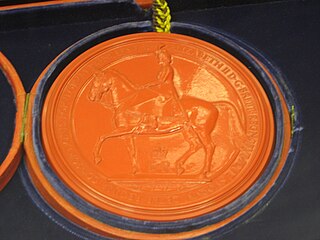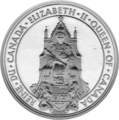
The monarchy of Canada is Canada's form of government embodied by the Canadian sovereign and head of state. It is one of the key components of Canadian sovereignty and sits at the core of Canada's constitutional federal structure and Westminster-style parliamentary democracy. The monarchy is the foundation of the executive (King-in-Council), legislative (King-in-Parliament), and judicial (King-on-the-Bench) branches of both federal and provincial jurisdictions. The current monarch is King Charles III, who has reigned since 8 September 2022.

The National Flag of Canada, often simply referred to as the Canadian flag or, unofficially, as the Maple Leaf Flag or l'Unifolié, consists of a red field with a white square at its centre in the ratio of 1∶2∶1, in which is featured a stylized, red, 11-pointed maple leaf charged in the centre. It is the first flag to have been adopted by both houses of Parliament and officially proclaimed by the Canadian monarch as the country's official national flag. The flag has become the predominant and most recognizable national symbol of Canada.

The coat of arms of Canada, also known as the Royal Coat of Arms of Canada or, formally, as the Arms of His Majesty The King in Right of Canada, is the arms of dominion of the Canadian monarch and, thus, also the official coat of arms of Canada. In use since 1921, it is closely modelled after the royal coat of arms of the United Kingdom, with French and distinctive Canadian elements replacing or added to those derived from the British version.

The House of Windsor is a British royal house, and currently the reigning house of the United Kingdom and the other Commonwealth realms. The royal house's name was inspired by the historic Windsor Castle estate. Since it was founded in 1917, there have been five British monarchs of the House of Windsor: George V, Edward VIII, George VI, Elizabeth II, and Charles III. The children and male-line descendants of Queen Elizabeth II and Prince Philip also genealogically belong to the House of Oldenburg since Philip was by birth a member of the Glücksburg branch of that house.

Emperor or Empress of India was a title used by British monarchs from 1 May 1876 to 22 June 1948 to signify their sovereignty over the Indian Empire as its imperial head of state. The image of the emperor or empress appeared on Indian currency, in government buildings, railway stations, courts, on statues etc. Oaths of allegiance were made to the emperor or empress and the lawful successors by the governors-general, princes, governors, commissioners in India in events such as imperial durbars.
The style and title of the Canadian sovereign is the formal mode of address of the monarch of Canada. The form is based on those that were inherited from the United Kingdom and France, used in the colonies to refer to the reigning monarch in Europe. As various Canadian territories changed ownership and then the country gradually gained independence, the style and title of the monarchs changed almost as often as the kings and queens themselves. The mode of address currently employed is a combination of a style that originates in the early 17th century and a title established by Canadian law in 2024.

The Great Seal of the Realm is a seal that is used to symbolise the sovereign's approval of state documents. It is also known as the Great Seal of the United Kingdom. To make it, sealing wax is melted in a metal mould or matrix and impressed into a wax figure that is attached by cord or ribbon to documents that the monarch wishes to seal officially. The formal keeper of the seal is the Lord High Chancellor of Great Britain.
The precise style of the British sovereign has varied over the years. It is chosen and officially proclaimed by the sovereign. In 2022, King Charles III was proclaimed by the Privy Council to have acceded to the throne with the style:
Charles the Third, by the Grace of God of the United Kingdom of Great Britain and Northern Ireland and of His other Realms and Territories King, Head of the Commonwealth, Defender of the Faith
The royal sign-manual is the signature of the sovereign, by the affixing of which the monarch expresses their pleasure either by order, commission, or warrant. A sign-manual warrant may be either an executive act, or an authority for affixing the Great Seal of the pertinent realm. The sign-manual is also used to give power to make and ratify treaties. Sign manual, with or without hyphen, is an old term for a handwritten signature in general. It is also referred to as sign manual and signet.

The monarchy of Australia is a key component of Australia's form of government, embodied by the Australian sovereign and head of state. The Australian monarchy is a constitutional one, modelled on the Westminster system of parliamentary government, while incorporating features unique to the constitution of Australia.

Canadian royal symbols are the visual and auditory identifiers of the Canadian monarchy, including the viceroys, in the country's federal and provincial jurisdictions. These may specifically distinguish organizations that derive their authority from the Crown, establishments with royal associations, or merely be ways of expressing loyal or patriotic sentiment.

In modern heraldry, a royal cypher is a monogram or monogram-like device of a country's reigning sovereign, typically consisting of the initials of the monarch's name and title, sometimes interwoven and often surmounted by a crown. Such a cypher as used by an emperor or empress is called an imperial cypher. In the system used by various Commonwealth realms, the title is abbreviated as 'R' for 'rex' or 'regina'. Previously, 'I' stood for 'imperator' or 'imperatrix' of the Indian Empire.

Elizabeth II was proclaimed queen throughout the Commonwealth after her father, King George VI, died in the early hours of 6 February 1952, while Elizabeth was in Kenya. Proclamations were made in different Commonwealth realms on 6, 7, 8, and 11 February. The line of succession was identical in all the Commonwealth realms, but the royal title as proclaimed was not the same in all of them. Accession was followed sixteen months later by the Coronation of Elizabeth II at Westminster Abbey in London on 2 June 1953.

The monarchy of Canada forms the core of each Canadian provincial jurisdiction's Westminster-style parliamentary democracy, being the foundation of the executive, legislative, and judicial branches of government in each province. The monarchy has been headed since September 8, 2022 by King Charles III who as sovereign is shared equally with both the Commonwealth realms and the Canadian federal entity. He, his consort, and other members of the Canadian royal family undertake various public and private functions across the country. He is the only member of the royal family with any constitutional role.

The monarchy of Saint Lucia is a system of government in which a hereditary monarch is the sovereign and head of state of Saint Lucia. The current monarch and head of state, since 8 September 2022, is King Charles III. As sovereign, he is the personal embodiment of the Saint Lucian Crown. Although the person of the sovereign is equally shared with 14 other independent countries within the Commonwealth of Nations, each country's monarchy is separate and legally distinct. As a result, the current monarch is officially titled King of Saint Lucia and, in this capacity, he and other members of the Royal Family undertake public and private functions domestically and abroad as representatives of the Saint Lucian state. However, the King is the only member of the royal family with any constitutional role.

Since unification in 1910, South Africa has used a range of national symbols to identify the country: coats of arms, official seals, flags, national anthems, and floral, bird, animal, and other emblems.

The Tudor Crown, also known as the Imperial Crown, is a widely used symbol in the heraldry of the United Kingdom. In use officially from 1902 to 1953 and again from 2022, it represents both the British monarch personally and "the Crown", meaning the sovereign source of governmental authority. As such, it appears on numerous official emblems in the United Kingdom, British Empire and Commonwealth.
The Great Seal of Newfoundland is a seal used to authenticate documents issued by the government of Newfoundland and Labrador that are released in the name of the King in Right of Newfoundland and Labrador, including the appointment of the Executive Council and Ministers.
Charles III became King of the United Kingdom and of 14 other Commonwealth realms upon the death of his mother, Elizabeth II, on 8 September 2022. Royal succession in the realms occurs immediately upon the death of the reigning monarch. The formal proclamation in Britain occurred on 10 September 2022, at 10:00 BST, the same day on which the Accession Council gathered at St James's Palace in London. The other realms, including most Canadian provinces and all Australian states, issued their own proclamations at times relative to their time zones, following meetings of the relevant privy or executive councils. While the line of succession is identical in all the Commonwealth realms, the royal title as proclaimed is not the same in all of them.

The Great Seal of Australia is one of Australia's national symbols. It is used on some important documents to demonstrate the approval of the Commonwealth. As the imprint of the seal could not be easily reproduced by government printers, its presence is shown by the initials "L.S" for locus sigilli on copies of sealed documents. The current design was authorised by royal warrant on 19 October 1973. The Department of Prime Minister and Cabinet currently holds custody of the seal.


















